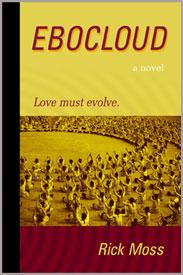Monday, February 7, 2011
Ebocloud, A Novel About The Social Singularity | Singularity Hub
The Singularity may arrive through robots, computers, or bioengineering…or it might be created by Facebook. Ebocloud, the debut novel from Rick Moss, is set in a not-too-distant future where a fictional social network is responsible for slowly knitting lives together. The novel’s ‘Ebocloud community’ transforms strangers into clusters of ‘cousins’ and from ‘cousins’ into possibly much more. Moss leads us through a harrowing detective story set against the backdrop of the evolution of this social network, exploring the uncertainty and absurdity of a society where individuality might be converging into a collective consciousness. Parts of the novel read like a tribute to Kurt Vonnegut, with a story within a story told in his style. Even the idea of ‘Ebo-cousins’ is taken from Vonnegut’s real-life proposal for an extended family system. Moss succeeds in channeling some of the master’s comedy, insight, and entrancing narrative while leaving us to question how humanity will evolve in the 21st century. Will we go the way of cold reason and artificial intelligence, or will our interconnectedness become something greater than we could possibly imagine?
The Social Singularity
In Ebocloud, the social network (named Ebocloud itself) becomes one of the world’s most popular social forums. It does this by rewarding its users with real world benefits. When you sign up for Ebocloud you are randomly assigned to an extended family of Ebo-cousins and you receive points (‘kar-merits’) for helping them out. You can ask for help in turn, with preference given to those with the most kar-merits. This sort of social network-enabled altruism leads to strong ‘tribal’ identities, which only grow stronger as a trendy new BCI (think iPhone meets EEG) allows Ebocloud users to feel the presence and needs of their Ebo-cousins. Slowly, the Ebo-community starts to evolve into collective consciousness.
Sound far-fetched? Well, it is science fiction.
Yet underneath the fiction is a very intriguing theory about social singularity. What do I mean by social singularity? Imagine that instead of merging with machines of superior intelligence, or building machines with superior intelligence to replace us, we instead began to merge with each other. Thoughts shared through tweets and Facebook status updates would evolve into sharing actual thoughts through the creation of a new generation of BCI. Eventually, perhaps, the thoughts between humans would become more than the sum of their parts so to speak. It’s another path towards superior intelligence, one based upon collective, rather than individual, knowledge.
In a world where social networks dominate discussions in the mainstream media (heck, maybe they are the new mainstream media) it’s hard to ignore the possibility that such systems could one day radically alter civilization as much as hard-science technology. Singularity Hub has discussed how mores about privacy may change in the new generation raised on Facebook and Twitter, and personal interactions are clearly changing as more of us become addicted to our mobile phones and tablet computers. When you spend the majority of your day-to-day life online or thinking about things online, the power of tech-augmented human interconnectedness seems very real.
An Ultra-Brief Book Review
While the evolution of the Ebocloud social network shapes the world of the novel, the story itself is of Ellison Luber, a New York City artist who’s girlfriend may have tried to kill him by setting his apartment on fire. As ‘Ellie’ recruits his nephew, old high school acquaintance, and some of his new Ebo-cousins to help him solve this personal mystery, the greater wonders of the Ebocloud begin to unfold. Is its creator, the visionary billionaire Radu Cajal, simply out to change the world for the better, or is there something more sinister lurking in the Eboclouds’ complex piles of computer code? In true science fiction fashion, Ellie’s race to locate his girlfriend/assassin becomes a journey to understand the powers and promise of the Ebocloud. In this way the novel is reminiscent of Vernor Vinge’s Marooned in Realtime, one of the new science fiction classics that helped popularize the concept of the Technological Singularity.
I’m not a professional book reviewer, so I can’t speak to Moss’ prose, but I was fairly impressed with his feeling for plot. The novel starts off too slow, hung up on some rather poor dialogue at first (including a rather dreadful conversation between jazz musicians), but once Moss hit his stride the story became very engrossing. Ebocloud isn’t mindless narrative candy like a Dan Brown novel, it challenges you a little more than that. Yet the unexpected twists and turns of its story are telegraphed just enough that the reader can feel surprised without being completely confused.
Moss really shines in the story within a story, an overt tribute to Kurt Vonnegut that plays just right. “The Venaries of Planet Flounce” reads like a forgotten short-story of Vonnegut’s, one that is part space-opera, part political commentary, and part absurdist farce. As Ebocloud’s protagonist reads “…Flounce” we’re treated to some wonderful (and often explicitly drawn) parallels between the meta-fictional world and the fictional one.
I had a chance to speak with the author briefly about Ebocloud, and his idea for a singularity driven by social media. Unsurprising, perhaps, Moss himself is in the business of social networks – he is the co-founder and president of RetailWire.com, an online forum and news feed for the retail industry. Moss started writing in 2007, driven by the death of Vonnegut, frustration with war profiteering, and the growing prevalence of mobile interfaces. The novel’s arrival at discussing a social singularity happened rather organically. Which is rather fitting, perhaps, as the reader leaves Ebocloud questioning the popularity of Facebook (and social media in general) as something more than simply a fad. Moss arrives at the concept of social singularity somewhat on his own, so maybe we’re all about to walk around the corner and stumble into it ourselves.
Whether you think the social singularity is crazy or not, I recommend Ebocloud as a good way to introduce yourself to the concept. It’s less than 400 pages, and a pleasant read. Especially if you like your science fiction with hints of Vonnegut. The paperback is available at $16, with Kindle versions running at $10 on Amazon. Other e-books as low as $5 (you can of course order any of these formats through the Ebocloud website).
After the atom bombs of the 1940s, the science fiction of the 1950s was filled with tales of societies fueled by nuclear power. Now that social networks have made their deep impacts on the globe, the next wave of sci-fi could trumpet civilizations based upon this new media. If so, Rick Moss could be among the first to help define a new branch of the genre. Even if it doesn’t, Ebocloud isn’t a bad way to spend a weekend in the park. Enjoy.
TI announces OMAP 5: two high-performance and two low-power cores, devices next year -- Engadget
By Chris Ziegler posted Feb 7th 2011 12:24PM
Breaking News
We're still waiting for the first OMAP 4 devices to hit the market, but TI's planning ahead -- way ahead -- with its announcement today of the OMAP 5 platform that really kicks things into high gear. The headline feature would be the inclusion of two Cortex-A15 cores, each running at up to 2GHz; Cortex-A15 is the fastest architecture ARM has announced to date, featuring performance roughly 50 percent better than Cortex-A9 at the same clock speed. What's more, there are another two Cortex-M4 processors along for the ride, ready to take over less intensive tasks at much lower power consumption to improve device responsiveness. The platform can support up to four cameras operating at the same time, offer 3D playback, recording, and 2D upsampling to 3D at 1080p resolution, and control up to 8GB of RAM. The chips start sampling to device manufacturers in the second half of this year with retail devices expected in the second half of 2012. Follow the break for the full press release."







